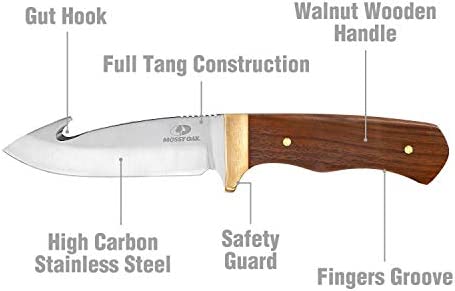Know How to Sharpen Gut Hook Blades and Keep Them Razor Sharp
Learn the best methods to sharpen and maintain your gut hook blades to keep them razor-sharp. Find out how easy it is to create a perfect edge on your blade quickly and safely.
Sharpening a gut hook knife is crucial for hunters, fishermen, and outdoor enthusiasts alike. Not only does a dull blade make for a frustrating and inefficient experience, but it can also put you in danger. A well-honed gut hook blade should slice through skin smoothly and effortlessly, making your job easier and more enjoyable.
In this article, we'll guide you through sharpening your gut hook blades, from understanding their anatomy to maintaining their sharpness.
Whether you're new to the game or an experienced outdoorsman, this comprehensive guide covers you. Get ready to take your gut hook to the next level!
Understanding the Anatomy of a Gut Hook
A gut hook knife is a specialized hunting knife that helps in field dressing game animals. It is an essential tool for hunters and fishermen to quickly and efficiently process their catch. To effectively sharpen a gut hook, it is important to understand its anatomy and how it works.

Parts of a gut hook
As you can see, the gut hook knife consists of a blade, typically made of high-quality steel, and a handle similar to a skinning knife. But it has an additional blade feature, the sharp semi-circular hook-like structure pointing inward, present at the end of the blade.
At the very tip, the hook point allows you to snag hard-to-reach spots while giving you extra control while skinning game animals. So, this part has to be sharp and maintained properly so that it can easily glaze through any game's skin during field dressing.
However, this hook makes the sharpening a bit tricky compared to other tools.
How it Works
The gut hook works by making a clean and precise incision into the skin of an animal, allowing the hunter or fisherman to open it up and remove its innards quickly. The curved edge of the gut hook helps to minimize the damage to the meat, making it easier to process and preserve the meat.
Understanding the Bevel Angle
The bevel angle refers to how sharply angled the point meets with its corresponding blade edge; understanding this angle can help you determine which type of sharpening stone will work best on your knife's particular angle to get optimal results.
This angle is critical in determining the sharpness and effectiveness of the gut hook. A steeper bevel angle will create a sharper edge, while a shallower angle will result in a duller edge. Maintaining the same bevel angle during the sharpening process is important to ensure consistent results.
A common bevel angle for a gut hook is around 18-22 degrees. When sharpening a gut hook, it is important to maintain the correct bevel angle to ensure optimal performance.
If you love hunting, check out our article on the best rifle slings.
The Tools You'll Need
When preparing to sharpen your gut hook, there are several tools required for doing so efficiently and effectively — these include different types of
· Sharpening stones (such as diamond or ceramic stones) and rods are essential for sharpening the blade.
· Honing oil or water for lubricating your stone before the process
· Strop, which helps remove burrs from your blade for the final polishing stage.
· Other miscellaneous tools, such as a honing guide for maintaining a steady sharpening angle or polishing compound, depending on your type of stone.
Knowing what type of stone will work best with your specific knife model is important — some may require finer grits than others, so read any specific manufacturer instructions if necessary for best results! Alternatively, if you have an electric knife sharpener, you can do it easily without additional tools.
Preparing Your Gut Hook for Sharpening
Once all tools have been acquired, it’s time to start preparations before actually beginning the sharpening process:
· Cleaning off any dirt or debris on your blade.
· Applying honing oil or water as necessary;
· Check the bevel angle against your reference stone to make sure it matches correctly for the smooth edge.
· For the curved hook, you have to check which portion of your stone corresponds to the fine inner edge of the gut hook. Think of it like sharpening serrated-edged blades with a single large curved hook instead of serrations.
· If you use a sharpening rod, ensure it fits within the hook.
· Clear your workbench and Set up a vice if available (or using some other form clamp) with whatever type of guide your particular stone/knife combination needs — each varies slightly depending on make/model, so refer accordingly.
Also, check out our article on the Best Soft Rifle Cases.
Sharpening Your Gut Hook
Using a sharpening stone, run your gut hook along its length in one direction at an even pressure.
Keep the angle correct while you work down each side of the blade evenly until you start to feel burrs forming on either side of the blade's edge.
This indicates that it is ready for flipping over and doing again on the other side until reaching desired sharpness.
Repeat the similar method using long strokes if it has a smooth edge.
After both sides are done, use a strop or abrasive paper/polishing compound to refine its edge further if desired.
Once both sides are complete, inspect your work closely by carefully running your thumb against either side - if it passes without snagging, you are ready to go!
Repeat these steps after use to ensure your gut hook stays in top condition all season.
Also, check out our article on the best mechanical broadheads.
Maintaining The Sharpness Of Your Gut Hook
It is especially important to properly maintain your gut hooks' level of sharpness as they often get dulled quickly due to their delicate nature - improper storage can also lead to them becoming brittle over time if not taken care of properly.
To minimize this risk, always ensure they are stored separately from other tools to avoid accidental damage occurring while not in use.
Clean them thoroughly after each use before drying them off completely with some soft cloths and applying some light oil if necessary (depending on the material used).
Finally, make sure that you regularly sharpen them as needed since regular maintenance will prevent them from becoming dull quicker than usual, which could drastically affect their performance when hunting outdoors in extreme conditions!
Master the art of rifle sling attachment without swivels with our comprehensive guide.
Final Thought
In conclusion, proper maintenance and regular sharpening will keep your gut hooks in tip-top shape for years - ensuring that every hunt succeeds! With these simple steps, you will soon become an expert in keeping your favorite hunting tool razor-sharp!
And when you are in the market for a new gut hook knife, check out our article for the best gut hook knives you can buy. Just tap the button below to see our top picks.
And when you need to keep your hunting tools razor sharp, don't forget to pick a hunting knife sharpener from one of our top picks; tap the button below and get one of our top picks for maximum efficiency and the easiest sharpening process!

